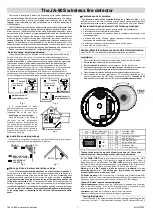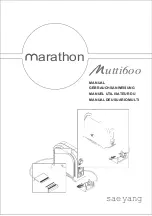
5
Drill and tap a 1/4" NPT hole using a 7/16" drill bit on the return side of the pool
plumbing at a location just downstream of the filter, but upstream from the AQL-CL
Electrolytic Cell. Use caution not to tap tapered threads too deeply. Using teflon
plumber's tape, install a tubing connector into the hole. Run flex tubing from the
tubing connector to the influent Probe Cell port. Push the flex tubing all the way into
the pressure fitting to seat.
Drill and tap another 1/4" NPT hole on the supply side of the pool plumbing. Use
caution not to tap tapered threads too deeply. Using teflon plumber's tape, install the
remaining tubing connector and run flex tubing to the effluent Probe Cell port. Push
the flex tubing all the way into the pressure fitting to seat.
Cut a 3" length of flex tubing and insert it into the sample stream port. This port can be
used to draw water samples if needed.
If flex tubing needs to be replaced, use only 3/8” UV-resistant cross-linked polyethyl-
ene tubing (PEX).
Installing ORP and pH probes to the Probe Cell
The ORP and pH probes are shipped "wet" in plastic storage caps. It's very important
that the probes remain wet at all times. If the probes are allowed to dry out, they will
fail and the AQL-CHEM will be ineffective. After installation, the Probe Cell will en-
sure that the probes are constantly exposed to pool water. During periods when the
filter pump is off (even extended periods), there should be sufficient moisture remain-
ing in the Probe Cell to ensure that the probes are protected.
Remove the ORP and pH probes from their plastic storage caps and save the caps for
future use. To ensure that the probes continue to remain wet, fill the Probe Cell with
pool water before installing the probes. Apply a length of plumber's tape to the probe
threads. Hand-tighten the probes only. At startup, check for leaks. If probe leaks, do
not tighten more—instead remove and re-apply new Teflon tape.
pH
Probe
ORP
Probe
apply teflon
plumber's tape
to threads
Controlling pH with the Aqua Rite Pro or Pro Logic
Plaster pools and pools serviced by salt-chlorine generators typically cause a slow
pH rise which must be managed. With the Sense and Dispense technology, CO2 or
acid is dispensed into the filter system’s return water as needed until the pH probe
reports proper pH level.
Hayward strongly recommends CO
2
injection instead of acid feed systems for pH
control of residential pools. Both systems are effective at reducing pH, but CO
2
is
much safer to handle and store. The Hayward AQL-CHEM2(-240) are CO
2
dispensing
systems that eliminate the need to handle acid and are economical and efficient meth-
ods for effective pH control. When the CO
2
gas is injected into water, it dissolves and
becomes carbonic acid, a weak acid that is very effective at lowering pH but becomes
self-limiting if over-fed.
IF YOU CHOOSE AN ACID FEEDER FOR pH CONTROL, additional safety precau-
tions are required to ensure that an equipment malfunction is detected. Great care
must be taken when installing, maintaining and operating acid pump feed systems.
Acid is dangerous to handle, and will harm people and equipment if not properly
contained, transported, poured, stored, and dispensed.
CAUTION
: Equipment failure can potentially cause too much acid to be dispensed
into the water, causing an equipment and health hazard which would not be detect-
able without the use of independent pH measurement.
•
Always use a 4:1 dilution in the acid feed system.
•
To prevent violent boiling and splashing, ALWAYS ADD ACID TO WATER,
never add water to acid to dilute it. Some use the rhyme “Remember, do as you
oughta- add acid to water”
•
Strictly follow the acid vendor’s safety and handling protocols including hand,
body and eye protection when transferring or handling acid.
•
Choose a 5 gallon per day acid feed pump to keep flow rate low.
•
Limit the available acid reservoir to 1 gallon per 15,000 gallons of water. This
limits the available acid in the event that equipment malfunctions and empties
the tank into the pool or spa.
•
Only a properly installed and maintained system will control the pH and sanitizer
levels of the water.
•
If acid is not diluted properly or the feed pump is oversized, it will overshoot the
pH correction.
•
Periodically use an independent pH and chlorine test kit to verify that pH is at a
safe level, and that chlorine is at a safe level. If the probes are broken, depleted,
dirty, fouled with oils, lotions, or other contaminants, they can report inaccurate
result to the system causing incorrect water chemistry, which at worst, could
harm people or equipment.
•
Check the Aqua Rite Pro or Pro Logic’s display each day before entering the
water. If there is any Check System alarm, following the troubleshooting guide in
this manual to understand and rectify the condition. If the display is blank, or
reporting a communications error, troubleshoot the equipment and rectify the
failure before entering the water.
•
Follow the installation checklist to verify proper operation upon installation and
at the beginning of each pool season.
14




























